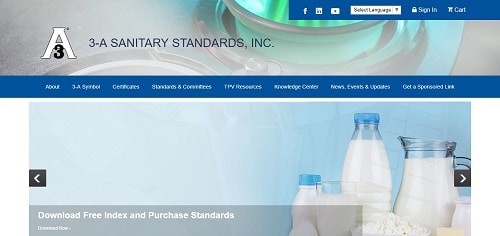For those working in today’s food equipment manufacturing and purchasing, engineering management, and quality assurance fields, it’s becoming increasingly important to familiarize yourself with the discipline of 3-A sanitary standards and accepted practices. The more thorough your understanding of the current materials standards, the less at risk you are of exposing your customers to unsanitary or contaminated food products.

A Definition of 3-A Sanitary Standards
3-A was originally developed in the 1920s as a standard’s development practice by the professional sanitarians, equipment fabricators, and processors interest groups. These days, the 3-A Administrative Symbol Council represents the USDA and the FDA as 3-A Sanitary Standards, Inc, otherwise known as 3-A SSI. For decades, the symbol exclusively applied to the dairy industry, but now food processors are following the lead to better streamline reviews and inspections.
The main standards and practices that adhere to 3-A SSI’s mission are 1) to protect food meant for human consumption from contamination and 2) to guarantee that all product contact surfaces can be mechanically cleaned and dismantled manually for thorough inspections. Examples of these are smooth, accessible, and easy-to-remove surfaces that are non-toxic, non-absorbent, and corrosion-resistant. Perhaps unsurprisingly, the surface in which food touches or is prepared must also be completely free of lead or lead solder.
The Key Benefits of the 3-A Sanitary Standards and Accepted Practices Lie in the Specialized Equipment
- Processors benefit from compliance- Long-time processors who specifically use dairy processing equipment in their business understand the importance of using methods that intrinsically adhere to sanitation codes. By investing in equipment that was designed with the 3-A Sanitary Standards in mind, these businesses have equipment that is simple to take apart and clean and might even contain mechanical cleaning methods that promote other sanitary codes.
- Regulatory sanitarians benefit from guaranteed standards- One of the best parts about using 3-A standards and practices to the fullest extent, especially in terms of equipment choice, is the fact that businesses know that all sanitary needs are being sufficiently met. The equipment is designed for quick inspection and discourages contamination, all of which makes for a clear-cut inspection process whenever it may arise.
- Equipment manufacturers benefit from the 3-A Symbol- The biggest and most influential equipment producers participate in the 3-A program for good reason – the symbol practically guarantees that its customers will be producing safe food products with little risk of contamination. For equipment manufacturers, specifically, this equates to happy customers who are placing their trust into USDA and FDA-approved products.
Why Adhering to all 3-A Sanitary Standards and Accepted Practices Might Be a Challenge for Some 
- High cost of upgrades- Purchasing entirely new equipment, especially those that are valuable fixed assets for a producer, can be a particularly difficult decision to make – even if the equipment might make the company run more safely and efficiently. As mentioned above, the 3-A Symbol has been a mainstay in the dairy industry for decades, but other food producers are slowly growing hip to its benefits. Unfortunately, for these companies, 3-A Symbol equipment usually comes at a higher price than the typical alternatives; this makes the purchase prohibitive for some.
- Employees must be well-trained for use and maintenance- Making the switch to 3-A will safeguard your business during inspections and reviews, but the specialized equipment only works well if your employees use it correctly. This means that it cannot be installed and used immediately; all employees that touch it must have a clear understanding of why the piece promotes 3-A sanitary standards and how they can best ensure that it is used as it was designed.
- Fraud is rampant in 3-A- Because 3-A compliance has diversified in recent years, it comes as no surprise that companies the world over are attempting to cash in on the symbol. To be granted the 3-A symbol, manufacturers must go through a rigorous authorization process, so when false symbols are advertised, organizations like 3-A Standards, Inc. make it known via their website. Investing in these unauthorized products does not guarantee you the same allowances as those with genuine ones, and it could bring you back to square one both financially and in terms of inspection violations.
A Quick Review on Why Your Business Should Consider the 3-A Symbol
There are many benefits to following the 3-A Sanitary Standards. Aside from regulatory compliance, compliance with strict regulatory standards provides a competitive edge and fosters confidence in your brand among both partners and consumers. To recap, here are just a few compelling reasons to consider the 3-A Symbol:
- It ensures that your company is taking advantage of cutting-edge hygienic design and technology.
- Equipment with the 3-A Symbol is made to easily come apart for hassle-free inspections and thorough cleanings.
- Your company will be covered by the highest of USDA and FDA gold standards. This means that, when used appropriately, any food that comes in contact with your specialized equipment has the lowest risk possible of becoming contaminated. It’s not only an investment in the health of your business, it’s also an investment in the health of your customers.
Related Posts:
- MPC’s Industrial Safety Quiz–Preliminary Results
- The Life-Saving Importance of Medical Labels
- 15 Practical Workplace Safety Apps for Apple and Android
- The Complete NADCAP Guide: Auditing, Accreditation, Requirements, and More

